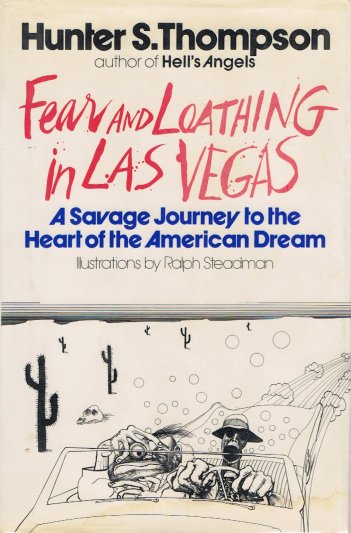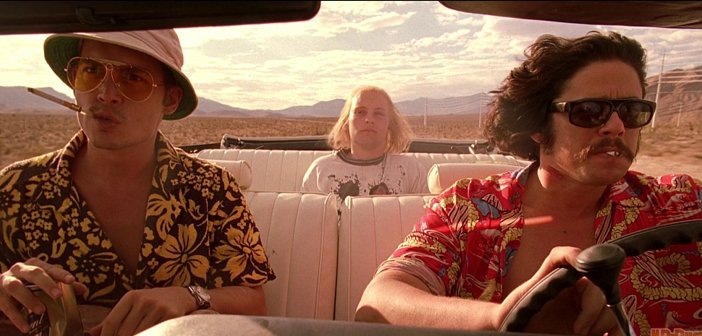Literature on Film | 11 | Fear and Loathing with Hunter S. Thompson
To some, Hunter S. Thompson is massively overrated. To others, he is a shining beacon of God-like wonder; an embodiment of all that is good and right and just about drug culture. Of the two types of Thompson observers, I am the former. While it is definitely a case of each to their own when drug use is concerned, I believe Thompson is a physical glorification of drug culture. I have witnessed time and time again f-bois claiming that Thompson is their idol because ‘he dropped acid too’. This is not a legacy one should wish to carry, but then, Hunter S. Thompson was in a league of his own. Everything he wrote and did in his lifetime was way out there, without a doubt, regardless of how truthful the events contained within his accounts were. Despite my feelings that he is generally overrated, objectively assessing how his book and the film compare was easy. Thompson may be problematic at best, but some of his descriptions were so vivid that it could only have taken one hell of a director to be able to bring that to life.

‘We were somewhere around Barstow, on the edge of the desert, when the drugs began to take hold.’ So opens Hunter’s somewhat infamous 1971 classic, Fear and Loathing in Las Vegas, as does the subsequent 1998 film adaptation. Regarded widely as a cult classic, Fear and Loathing is a possibly true tale of the time Thompson, under the pseudonym Raoul Duke and played by Johnny Depp (who is facing some serious allegations at this time and as such, I am loathe to say much about him at all until more of the story comes out) spent driving around the Nevada desert with psychopathic faux-attorney Dr. Gonzo – played by Benicio Del Toro – committing fraud to get reporting jobs and fancy hotel stays while under the influence of acid, mescaline, ether and alcohol (to name but a few). At best, the novel is a dreamlike depiction of the transgressive state of mind many Americans experienced around the 1970s, when the idea of locating the ‘Great American Dream’ was a life goal for so many people. At worst, it is the convoluted ramblings of a man in the depths of a drug dependency, and may not have happened at all. Most will attest to Fear and Loathing being entirely a work of fiction, though due to the nature of the beast himself, it’s still entirely unknown just how much of the story actually happened to Thompson, or how much he drew on from personal experience.
The 1998 adaptation of the book, written and directed by Terry Gilliam, was admittedly as loyal to the original work as anyone could hope for it to be, probably due to the deep involvement Thompson had in the production process. In an unprecedented turn of events (said no one) Johnny Depp led viewers in 113 minutes of film comprising mostly of scenes of Depp running around with a fly swatter, taking various drugs, muttering about bats, rambling incessantly about having a bad heart and reiterating the importance of the American Dream for other people – which anyone could objectively say is the basic crux of the novel.

Gritty and occasionally difficult to watch, Gilliam achieved what is arguably the impossible: he made sense of nonsense. Reading the book itself, it’s easy to see why it appealed to so many. The great Hunter S. Thompson, living by his own rules, exploring the inexplorable, glorifying drug culture. Brought to life, several things that were questionable in the novel become crystal clear in visual representation. One, is that the explanation of the start of Duke’s – and, perhaps, Hunter’s – own drug issues are more tangible than in the novel. Scenes where Duke is tripping on acid or mescaline were usually very detailed visual descriptions that become more understandable to non-users when expressed in cinematic form. Lounge monsters and strange things falling from the ceiling were easier explained when one can see Depp-as-Duke sitting at a table in a bar while the world appears to unravel in front of his eyes.

Fear and Loathing is as introspective as it gets, with Duke constantly questioning his own motives, wanting to know if he really came ‘all the way to Vegas to work on a story’. Gilliam succeeded in depicting the seedy, filthy, gritty reality of Las Vegas, both the glitzy casinos and clubs, and the open, desert roads, which still juxtaposed Duke and Gonzo and the twisted nature of their habits. In several scenes the worst part of Vegas seems to be Duke and Dr. Gonzo themselves, completely at odds with the glamorous mask Vegas has kept a firm hold of over the years. Perhaps the most harrowing scene involved Duke and Dr. Gonzo visiting a diner, where Dr. Gonzo hands the waitress a napkin with a derogatory comment on it – which may or may not be interpretable as a request of prostitution services, but is most likely a further exploration of an obsession with sodomy that would have Freud talking about the anal phase faster than, well, you could discuss it yourself. The waitress, rightly so, reacts badly, and Dr. Gonzo pulls a knife on her. The scene is sparse yet says so much about the tenuous grasp Gonzo has on reality, excellently executed by Del Toro. Duke comments later that the look on the waitress’s face suggested that ‘her throat had been cut before’, really driving home the suggestion that the glamour of Vegas is but a veil for more sinister happenings.
The second most apparent thing is that, despite the facetious nature of the film, it is truly an in-depth exploration of drug culture in the 70s. While it was easy to get caught up in the wild, rambling prose of the novel, Gilliam made great use of protest and war imagery to convey what exactly Thompson meant when he asked if his peers were ‘still humping the American Dream.’ Both the desire to do anything and become anyone one wanted to be were firmly wrapped up in the notion that hallucinogens were key to getting the answers out of life. In essence, it ensnares the tail-end of the hippie zeitgeist and the eternal optimism that went with that cultural phenomenon. Indeed, that captured optimism is potentially why Fear and Loathing is so popular among those embroiled in drug culture today. Thompson is regarded as somewhat of a hero due the way he lauds the effects drugs have on the body, the experiences one has while under the influence, and the sheer fact he built a career around behaving like a rabid racoon and was famed because of it.

In a display of fierce loyalty to the novel, Gilliam ensured that the script contained Gonzo reporting – a style of journalism that is attributed to Thompson, where the journalist does not claim to be objective, and reporting often involves self-insertion or is drawn from personal experiences of an event. Duke is seen to narrate the happenings around him as they occur, and draws on that experience later from tape recordings. This is particularly apparent in the scene where Dr. Gonzo overdoses on acid, and Duke finds him in the bathtub of a hotel suite, attempting to kill himself by pulling a radio into the water with him. There is a distinct sense of apathy that isn’t quite as clear in the novel, but Depp conveys the complete levels of desensitisation Duke had reached from constant exposure to ‘drug people’. His apathy is only lifted when Dr. Gonzo screams and Duke shouts ‘Shit! He’s killing himself!’ as he rushes to stop him. Casting Depp as Duke was perhaps the best move any adaptation could have hoped to have made, as through notorious method acting, he captures the essence of Thompson succinctly and, dare I say, perfectly. Indeed, Depp had his head shaved by Thompson himself for the role, and most of the clothing worn by him in the film were Thompson’s own. There is an excellently placed moment where Duke has a flashback, seeing himself in a nightclub at the beginning of the crest of the acid wave in 1965 San Francisco, noting ‘There I was…Mother of God, there I am!’, and the camera pans revealing a cameo appearance of Hunter S. Thompson himself. In a way we can’t see in writing, the film showed just how Duke appeared to the outside world. Stumbling, rambling, dangerous and to a degree, a sad, shadow of a man wrapped up in a world that isn’t quite real.
The closing line of Fear and Loathing, ‘Too weird to live, too rare to die’, is an interesting point of conjecture. Saying it about the retreating form of Dr. Gonzo, Duke appears contemplative of the type of person Gonzo must be. And yet, on another level, the phrase serves to glorify drug use, and the arrogance of those who believe themselves to be invincible. Duke and Dr. Gonzo spent years running around, stealing, committing federal offences, buying and taking drugs, and believed themselves to be too weird to live, too rare to die. Possibly the most famous line from any cult film, the phrase has been appropriated as the title of a Panic! At the Disco album which aimed to capture the essence of Vegas – the depravity, the elegance and everything in between, as inspired by Thompson’s almost-inaccessible Vegas. In the end, though, Fear and Loathing threw up some interesting points about the purpose of drug culture – escapism and deliberate ignorance as to the nature of the truth of the American Dream. Perhaps Thompson is overrated – but what I do know is that his book made a damn good film.
Featured Image Source

